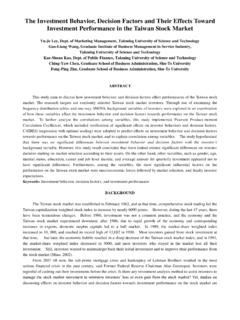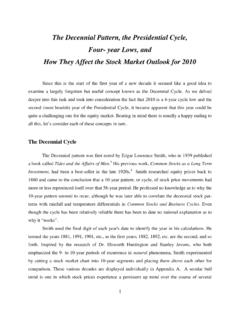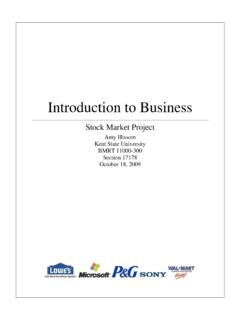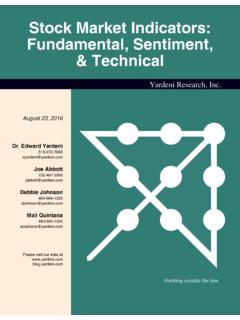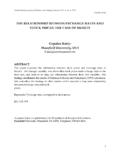Transcription of Forecasting stock market prices: Lessons for …
1 International Journal of Forecasting 8 (1992) 3-13 North-Holland Forecasting stock market prices: Lessons for forecasters * Clive G-anger University of California, Sun Diego, USA Abstract: In recent years a variety of models which apparently forecast changes in stock market prices have been introduced. Some of these are summarised and interpreted. Nonlinear models are particularly discussed, with a switching regime, from forecastable to non-forecastable, the switch depending on volatility levels, relative earnings/price ratios, size of company, and calendar effects. There appear to be benefits from disaggregation and for searching for new causal variables. The possible Lessons for forecasters are emphasised and the relevance for the Efficient market Hypothesis is discussed. Keywords: Forecastability, stock returns, Non-linear models, Efficient markets. 1. Introduction: Random walk theory For reasons that are probably obvious, stock market prices have been the most analysed eco- nomic data during the past forty years or so.
2 The basic question most asked is - are (real) price changes forecastable? A negative reply leads to the random walk hypothesis for these prices, which currently would be stated as: H,,: stock prices are a martingale. E[ P,+, I I,] = P,, where Z, is any information set which includes the prices P, _ j, j 2 0. In a sense this hypothesis has to be true. If it were not, and ignoring trans- action costs then price changes would be consis- tently forecastable and so a money machine is created and indefinite wealth is possible. How- Correspondence to: Granger, Economics Dept., 0508, Univ. of California, San Diego, La Jolla, California, USA 92093-0508. * Invited lecture, International Institute of Forecasters, New York Meeting, July 1991, work partly supported by NSF Grant SES 89-02950. I would like to thank two anonymous referees for very helpful remarks. ever, a deeper theory - known as the Efficient market Hypothesis - suggests that mere fore- castability is not enough.
3 There are various forms of this hypothesis but the one I prefer is that given by Jensen (1978): HC,2: A market is efficient with respect to infor- mation set 1, if it is impossible to make economic profits by trading on the basis of this information set. By economic profits is meant the risk-adjusted returns net of all costs . An obvious difficulty with this hypothesis is that is is unclear how to measure risk or to know what transaction costs are faced by investors, or if these quantities are the same for all investors. Any publically avail- able method of consistently making positive prof- its is assumed to be in I,. This paper will concentrate on the martingale hypothesis, and thus will mainly consider the forecastability of price changes, or returns (de- fined as (P, - P,_ , + D,)/P, _ 1 where D, is divi- dends), but at the end I will give some considera- tion to the efficient market theory. A good survey of this hypothesis is LeRoy (1989). By the beginning of the seventies I think that it was generally accepted by forecasters and re- $ 0 1992 - Elsevier Science Publishers All rights reserved 4 C.
4 Crunger / Forecasting stock market prices searchers in finance that the random walk hy- pothesis (or H,,,) was correct, or at least very difficult to refute. In a survey in 1972 I wrote, Almost without exception empirical . support a model for p, = log f , of the form dP,+, =~AP,+ I,-, +~t+l, where 0 is near zero, 1, contributes only to the very low frequencies and E, is zero mean white noise. A survey by Fama (1970) reached a similar conclusion. The information sets used were: I,,: lagged prices or lags of logged prices. ZZt: Ilr plus a few sensible possible explanatory variables such as earnings and dividends. The data periods were usually daily or monthly. Further, no profitable trading rules were found, or at least not reported. I suggested a possible reporting bias - if a method of Forecasting was found an academic might prefer to profit from it rather than publish. In fact, by this period I thought that the only sure way of making money from the stock market was to write a book about it.
5 I tried this with Granger and Morgenstern (1970), but this was not a financially successful strategy. However, from the mid-seventies and particu- larly in the 1980s there has been a burst of new activity looking for forecastability, using new methods, data sets, longer series, different time periods and new explanatory variables. What is interesting is that apparent forecastability is often found. An important reference is Guimaraes, Kingsman and Taylor (1989). The objective of this part is to survey some of this work and to suggest Lessons for forecasters working on other series. The notation used is: p, = a stock price, PI = log P,, D, = dividend for period t, Rr = return = (P, + D, - P,_,)/P,_,, [In some studies the return is calcu- lated without the dividend term and approximated by the change in log prices.] rr = return on a risk free investment, R, -rt = excess return, P = risk level of the stock , R, - r, - /3 X market return - cost of transac- tion = risk-adjusted profits.
6 The risk is usually measured from the capital asset pricing model (CAPM): R, - r, = p ( market excess return) + e,, where the market return is for some measure of the whole market , such as the Standard and Poor s 500. p is the non-diversifiable risk for the stock . This is a good, but not necessarily ideal, measure of risk and which can be time-varying although this is not often considered in the stud- ies discussed below. Section 2 reviews Forecasting models which can be classified as regime-switching . Section 3 looks at the advantages of disaggregation, Section 4 considers the search for causal variables, Section 5 looks at technical trading rules, Section 6 re- views cointegration and chaos, and Section 7 looks at higher moments. Section 8 concludes and re- considers the Efficient market Theory. 2. Regime-switching models If a stationary series X, is generated by: X, = (Y, + ylxI_, + E, if z, in A and X, = (Ye + y*x,_, + Ed if z, not in A, then x, can be considered to be regime switching, with z, being the indicator variable.))
7 If Z~ is a lagged value of x, one has the switching thres- hold autoregressive model (STAR) discussed in detail in Tong (1990), but z, can be a separate variable, as is the case in the following examples. It is possible that the variance of the residual E, also varies with regime. If x, is a return (or an excess return) it is forecastable in at least one regime if either y, or y2 is non-zero. Forecastability with Low Volatility LeBaron (1990) used R,, the weekly returns of the Standard and Poor 500 index for the period 194661985, giving about 2,000 observations. He used as the indicator variable a measure of the recent volatility 10 &,, = c Rf_, 1=0 C. Granger / Forecasting stock market prices 5 and the regime of interest is the lowest one-fifth quantile of the observed C? values in the first half of the sample. The regime switching model was estimated using the first half of the sample and post-sample true one-step forecasts were evalu- ated over the second half.
8 For the low volatility regime he finds a percent improvement in forecast mean squared error over a white noise with non-zero mean (that is, an improvement over a model in which price is taken to be a random walk with drift). No improvement was found for other volatility regimes. He first takes cy (the constant) in the model to be constant across regimes, relaxing this assumption did not result in improved forecasts. Essentially the model found is R, = cr + ,_1 + l t if have low volatility R,=cu+~, otherwise, where LY is a constant. This non-linear model was initially found to fit equally well in and out of sample. However, more recent work by LeBaron did not find much Forecasting ability for the model. 2. b. Earnings and size portfolios Using the stocks of all companies quoted on either the New York or American stock Ex- changes for the period 1951 to 1986, Keim (1989) formed portfolios based on the market value of equity (size) and the ratio of earnings to price (E/P) and then calculated monthly returns (in percentages).
9 Each March 31 all stocks were ranked on the total market value of the equity (price x number of shares) and ten percent with the lowest ranks put into the first (or smallest) portfolio, the next 10% in the second portfolio and so forth up to the shares in the top 10% ranked giving the largest portfolio. The portfo- lios were changed annually and average monthly returns calculated. Similarly, the portfolios were formed from the highest E/P values to the lowest (positive) values. [Shares of companies with nega- tive earnings went into a separate portfolio.] The table shows the average monthly returns (mean) for five of the portfolios in each case, together with the corresponding standard errors: Size E/P Mean ( ) Mean ( ) smallest ( ) highest ( ) 2nd ( ) 2 d ( ) S h ( ) gLh ( ) 9th ( ) gth ( ) largest ( ) lowest ( ) negative earnings ( ) ( ) Source: Keim (1989). It is seen that the smallest (in size) portfolios have a substantially higher average return than the largest and similarly the highest E/P portfo- lios are better than the lowest.
10 The two effects were then combined to gener- ate 25 portfolios, five were based on size and each of these was then sub-divided into five parts on E/P values. A few of the results are given in the following table as average monthly returns with beta risk values shown in brackets. Size E/P ratio Lowest smallest ( ) middle ( ) largest ( ) Source: Keim (1989). Middle ( ) ( ) ( ) Highest ( ) ( ) ( ) The portfolio with the highest E/P ratio and the smallest size has both a high average return and a beta value only slightly above that of a randomly selected portfolio (which should have a beta of ). The result was found to hold for both non-January months and for January, al- though returns in January were much higher, as will be discussed in the next section. Somewhat similar results have been found for stocks on other, exchanges. It should be noted that as portfolios are changed each year, transac- tion costs will be moderately large. The results are consistent with a regime- switching model with the regime determined by the size and E/P variables at the start of the year.

